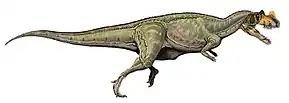Phuwiangvenator
Phuwiangvenator ("hunter of Phu Wiang") is a genus of megaraptoran theropod that lived during the Early Cretaceous period in what is now Thailand. It contains a single species, P. yaemniyomi, recovered from the Sao Khua Formation.[1] The holotype was first found in 1993, before being named in 2019.[2] The holotype specimen consists of a partial skeleton consisting of a dorsal vertebra, three fused sacral vertebrae, right metacarpal II, right manual phalanges and unguals, right and left tibiae, left astragalocalcaneum, left metatarsal I, right metatarsals II–IV, right pedal phalanges and unguals, with a referred specimen including an atlantal intercentrum and right astragalocalcaneum which were found together. In the phylogenetic analyses it was found to be the basalmost megaraptoran.[1]
| Phuwiangvenator | |
|---|---|
| Scientific classification | |
| Kingdom: | Animalia |
| Phylum: | Chordata |
| Clade: | Dinosauria |
| Clade: | Saurischia |
| Clade: | Theropoda |
| Clade: | †Megaraptora |
| Genus: | †Phuwiangvenator Samathi et al., 2019[1] |
| Species: | †P. yaemniyomi |
| Binomial name | |
| †Phuwiangvenator yaemniyomi Samathi et al., 2019[1] | |
References
- Samathi, A.; Chanthasit, P.; Martin Sander, P. (May 2019). "Two new basal coelurosaurian theropod dinosaurs from the Lower Cretaceous Sao Khua Formation of Thailand". Acta Palaeontologica Polonica. 64 (2): 239–260. doi:10.4202/app.00540.2018.
- "Mega-raptors were top predators in Thailand 100 million years ago". Plos. y Jon Tennant in Dinosaurs, Jon Tennant.













